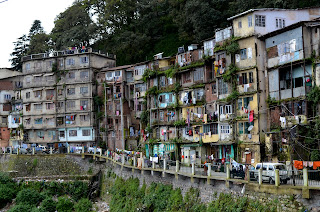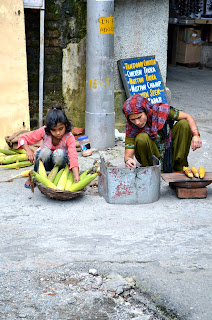Now that we've settled in to a routine in Mussoorie, I'm definitely overdue to describe what we've been doing here. We're staying at the Hanifl Center, the outdoor education center of the Woodstock School, a prestigious international school and one of the best in India. Compared to what the rest of our year will be like, we are practically living in the lap of luxury. The toilets still may not flush, the showers don't completely work, we seem to have a spider problem and the internet is pretty testy, but everything else about this place is wonderful! The dorms are clean, the beds are comfortable, the air is fresh, the weather is cool, and, best of all, the scenery is incredible. The best part of every day is waking up and looking out our dorm room window.
After that consistently breathtaking experience, every morning begins with a hike up the side of the mountain (literally) to the Landour Language School, where we take our Hindi classes. The lessons are intense, interesting and a bit intimidating, but definitely also fun. The language school, which specializes in intensive courses - basically like the Hindi version of ulpan - uses a really unique approach (which I'm still unsure how I feel about). Instead of starting by teaching pronouns and basic verbs, they throw piles of common vocabulary words at you ("common" being things like chhota (small), panni (water), qalam (pen), achchha (good) and so on and so forth), and every class (so far) have introduced a new question word (kya - what, kaisa - what kind, kahan - where, etc) and the means of answering it. So we've spent the past few classes mixing and matching vocabulary words in order to answer questions like "mez par kitab kaisi hai?" (what kind of book is on the table?) with "mez par kali kitab hai" (a black book is on the table), and yet, it wasn't until yesterday's class that I even learned how to say I, you, he or she (and still haven't learned we, they etc), and we still don't really know anything about conjugating verbs. But, then again, although the Hindi we're learning doesn't seem to be focused on realistic conversational ability, it is certainly focuses on practicality. After only two days of Hindi classes, we felt completely comfortable walking through town, with the ability to ask key questions like "what is this?" and "where is ____?" and to order X number of chais or sweets.
Unfortunately, Hindi is like no other language I've ever learned and is like nothing I've ever heard before, so although I'm having a lot of fun picking up new vocabulary and hearing exotic-sounding sentences come out of my mouth, I can already tell that the learning curve will be intimidatingly steep. Still, the easiest and the most fun and beautiful part of Hindi for me is the script. It uses an alphabet just like English does (so not characters like Chinese, thank goodness), which is called Devanagari, but just like the Hebrew or Arabic alphabet, looks absolutely nothing like the Roman letters we know. The letters, however, are beautiful, and fun to write, and deciphering them gives you a feeling of accomplishment unlike saying any spoken sentence.
After that consistently breathtaking experience, every morning begins with a hike up the side of the mountain (literally) to the Landour Language School, where we take our Hindi classes. The lessons are intense, interesting and a bit intimidating, but definitely also fun. The language school, which specializes in intensive courses - basically like the Hindi version of ulpan - uses a really unique approach (which I'm still unsure how I feel about). Instead of starting by teaching pronouns and basic verbs, they throw piles of common vocabulary words at you ("common" being things like chhota (small), panni (water), qalam (pen), achchha (good) and so on and so forth), and every class (so far) have introduced a new question word (kya - what, kaisa - what kind, kahan - where, etc) and the means of answering it. So we've spent the past few classes mixing and matching vocabulary words in order to answer questions like "mez par kitab kaisi hai?" (what kind of book is on the table?) with "mez par kali kitab hai" (a black book is on the table), and yet, it wasn't until yesterday's class that I even learned how to say I, you, he or she (and still haven't learned we, they etc), and we still don't really know anything about conjugating verbs. But, then again, although the Hindi we're learning doesn't seem to be focused on realistic conversational ability, it is certainly focuses on practicality. After only two days of Hindi classes, we felt completely comfortable walking through town, with the ability to ask key questions like "what is this?" and "where is ____?" and to order X number of chais or sweets.
Unfortunately, Hindi is like no other language I've ever learned and is like nothing I've ever heard before, so although I'm having a lot of fun picking up new vocabulary and hearing exotic-sounding sentences come out of my mouth, I can already tell that the learning curve will be intimidatingly steep. Still, the easiest and the most fun and beautiful part of Hindi for me is the script. It uses an alphabet just like English does (so not characters like Chinese, thank goodness), which is called Devanagari, but just like the Hebrew or Arabic alphabet, looks absolutely nothing like the Roman letters we know. The letters, however, are beautiful, and fun to write, and deciphering them gives you a feeling of accomplishment unlike saying any spoken sentence.
Hindi is always followed by chai and then the walk back down to the Hanifl Center. The middle of the day usually includes lunch and free time, orientation stuff and/or group activities. Starting this past Thursday, the staple of our afternoons became work at the Turner Organic Garden (although I have to admit that I haven't started working there yet due to a minor case of dehydration). The other option for our afternoons/evenings is walking in to town. Which is amazing. To get to town, you just follow the main road as it winds through the mountains and, eventually, stores begin to pop up alongside the street, and then more stores, and more people, until you reach Mussoorie's colorful, bustling center.
Mussoorie is like Delhi's infant sister. You see the same colors, clothing, dilapidation and liveliness, the same tiny shops, food stalls, and stray dogs, the same narrow streets, nonexistent sidewalks and crazy drivers, and yet, everything is infinitely more calm. Here, crazy drivers means a single car thundering around a curve with complete disregard for other beings in the road, whereas in Delhi it would probably be ten cars, seven motorcycles, five rickshaws, three trucks, two bikes and various pedestrians all attempting that same maneuver. Here, even when it's bustling and the streets are buzzing with people's energy, you still have space, and fresh, unpolluted, crisp-smelling air to yourself. Here, you have all the time in the world to stop and stare and take in the dazzling surroundings.
Our group spends evenings either with a Hindi tutor, at the Woodstock gym, in town, or just hanging out. Ada and I, while both sick in bed, were the first to venture into the wonderfully ridiculous world of Bollywood, watching movies complete with random dance numbers, murder, corruption and reincarnation. We even discovered our first favorite Bollywood songs/dances, which I'll post here for you to enjoy as well:)
Until next time,
H
















No comments:
Post a Comment